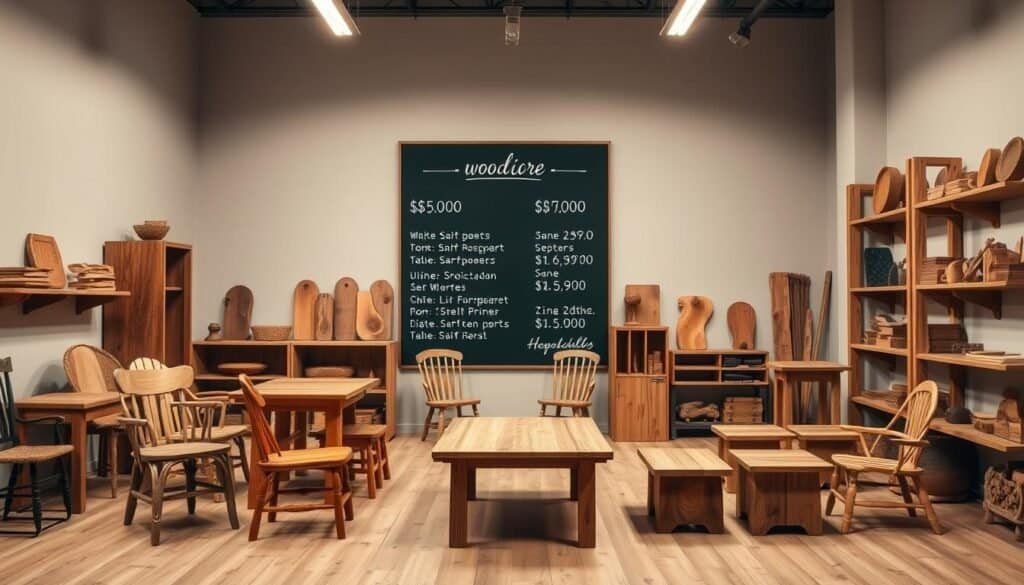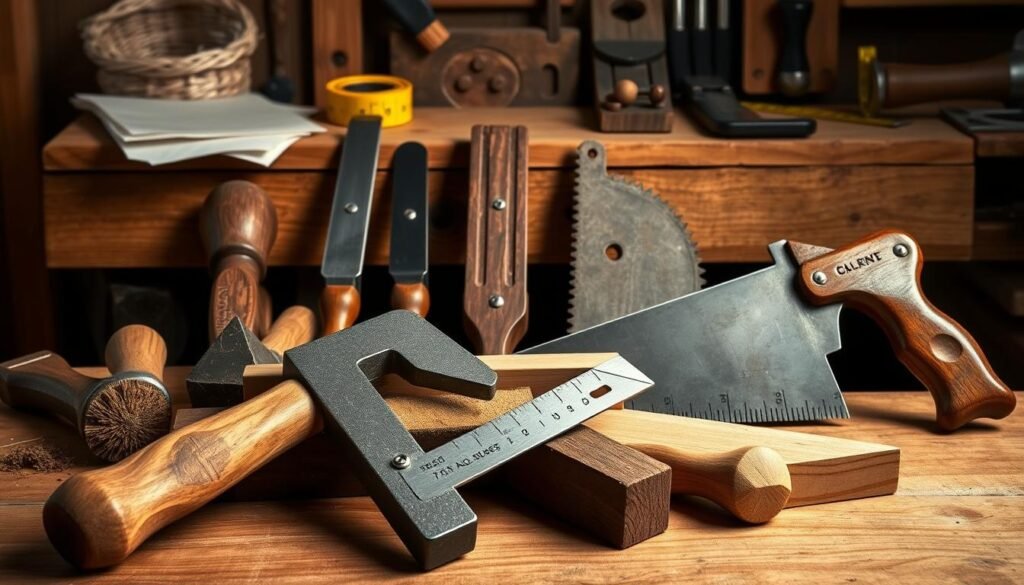Many hobbyists dream of making a living from their passion. Starting a woodworking business from home is now a real option. It’s thanks to the growth of home-based businesses.
Woodworking combines creativity with technical skills. This makes it a great business idea. By using your skills and love for woodworking, you can earn a steady income.
This article will help you start a woodworking business from your garage. We’ll cover the key steps and share important tips. This will help your business get off to a great start.
The Growing Opportunity in Woodworking Businesses
The woodworking industry is booming, thanks to people wanting unique, handmade items. This is a great chance for entrepreneurs to start a woodworking business from their garage.
The Rise of Artisanal and Custom Furniture
More and more people are looking for custom furniture that shows off their style. Woodworking businesses can tap into this by making furniture that’s made just for each customer.

There’s a big push for eco-friendly wood products, thanks to people caring more about the planet. Businesses can make a difference by using sustainable materials and reducing waste.
Low Overhead Costs and Tax Benefits
Starting a woodworking business at home can save a lot of money. Entrepreneurs can cut down on rent and utilities. They can also get tax breaks for business expenses.
Work-Life Balance Advantages
Working from home in woodworking means better work-life balance. It lets entrepreneurs manage their time better and spend more with family. This is a big plus for those wanting a business that fits their life.
Assessing Your Woodworking Skills and Specialization
First, you need to check your woodworking skills to start a successful business. Knowing your strengths and weaknesses helps you pick the right projects.
To really check your skills, think about these points:
Skills Assessment Checklist
:
- How good are you with woodworking tools and machines?
- Do you know about different woods and how to use them?
- Can you handle various woodworking techniques and joinery?
- Are you good at reading and following woodworking plans?
- Do you know how to finish wood with stains and varnishes?
After checking your skills, pick a woodworking area that fits your abilities and interests. You might choose furniture making, small crafts, or custom installations.
Furniture vs. Small Crafts vs. Custom Installations
Furniture making is about creating useful and beautiful pieces for homes and offices. Small crafts are decorative or useful items like cutting boards or coasters. Custom installations are special woodwork for specific spaces or needs.

Each area has its own challenges and chances. Furniture making needs precision and knowledge of ergonomics. Custom installations require creativity and working with clients to meet their needs.
By knowing your skills and choosing a focus, you can improve your skills and build a strong reputation in woodworking.
Creating a Solid Business Plan for Your Woodworking Venture
Starting a woodworking business begins with a solid business plan. This plan outlines your goals, target market, and financial outlook. It acts as a guide for your journey.
A good business plan keeps you focused on your goals. It helps you make decisions. It starts with your business model, like what woodworking products you’ll make and sell.
Startup Costs Breakdown
First, you need to figure out your startup costs. These include tools, equipment, materials, and licenses. Knowing these costs helps you understand your initial investment.
The cost of tools and equipment varies. It can range from a few hundred to several thousand dollars. This depends on the complexity and size of your business.

After starting, you’ll have monthly expenses. These include materials, utilities, marketing, and insurance. Understanding these costs is key to managing your finances well.
By planning your startup and ongoing costs, you build a strong financial base. This ensures your business is stable and can grow.
Legal Requirements for Starting a Woodworking Business from Your Garage
Starting a woodworking business from your garage needs careful legal steps. You must follow local laws and regulations. Knowing these rules is key to your business’s success and legality.
Choosing the Right Business Structure
Choosing the right business structure is a first step. You can pick from a sole proprietorship, partnership, LLC, or corporation. Each has its own benefits and drawbacks, like different levels of protection and taxes.
An LLC is often chosen for small businesses. It offers personal liability protection and tax benefits.
Liability Insurance and Property Coverage
Getting the right insurance is also important. Liability insurance covers you in case of accidents or damage to others. Property coverage protects your business assets, like tools and stock, from damage or loss.

You also need to check local zoning laws and get any needed permits or licenses. Start by talking to your local government to learn what you need.
By tackling these legal steps, you can make sure your woodworking business is set up right. This ensures it follows all laws and sets a strong base for success.
Transforming Your Garage into an Efficient Workshop
Turning your garage into a woodworking workshop is possible with the right planning. It’s key to create a space that’s organized and boosts your productivity.
Workflow-Based Organization
Having a well-thought-out workflow is essential. Arrange your tools in a way that makes sense for your projects. For example, set up areas for cutting, sanding, and assembly.

A dust collection system is a must-have. It keeps your area clean and protects you from dust. You can choose a central system or portable dust collectors.
Remember, keeping your dust collection system in good shape is important for its effectiveness.
Vertical Storage Options
It’s important to use space wisely in your workshop. Use wall-mounted cabinets, pegboards, and shelving for storage. This saves floor space and keeps tools handy.
With these steps, you can make your garage a productive woodworking space. It will help you work better and make quality products.
Essential Tools and Equipment for Your Startup Woodworking Business
Starting your woodworking business means first picking the right tools. The right tools make your products better and help you work faster and more efficiently.
It’s important to find a balance between cost and quality when starting. You don’t have to buy the most expensive tools at first. But, you should have the basic tools you need.
Budget-Friendly Options
When you’re just starting, look for affordable tools. Choose tools that are easy for beginners but are also good quality. Brands like DeWalt, Makita, and Bosch have tools that are both reliable and won’t break the bank.

Start with basic tools like a table saw, drill press, sanders, and hand tools like chisels and hand saws. You might also consider buying used tools or renting to save money.
When to Invest in Professional-Grade Tools
As your business gets bigger, you’ll need better tools. Professional-grade tools last longer and work better. This is key for making your products better and growing your business.
Buying professional-grade tools should be a careful decision. Wait until you really need them based on your business’s growth. Check your needs often to know when it’s time to upgrade.
Sourcing Quality Materials on a Budget
Finding top-notch materials without spending too much is a big challenge for woodworking entrepreneurs. It’s key to source well to make products that customers love.
Think about building relationships with local sawmills. They offer fresh, quality lumber at good prices. By getting to know sawmill owners, you can get better deals and a steady supply. This can also open doors to unique woods that make your products stand out.
Building Relationships with Local Sawmills
Going to local sawmills and talking to the owners can show you their quality and operations. This personal touch can lead to deals like getting materials first or discounts for big orders.
Just-in-Time Inventory Strategies
Using just-in-time inventory strategies can cut costs too. Ordering materials only when you need them saves on storage and waste. It needs good planning and working well with suppliers to get materials on time.

With strong local supplier relationships and smart inventory management, you can get quality materials without spending a lot. This makes your business more competitive in the market.
How to Start a Woodworking Business from Your Garage: Step-by-Step Process
Starting a woodworking business from your garage needs a clear plan. This plan helps you cover all important steps, from getting ready to launching your business.
Safety Protocols and Equipment
First, make your workspace safe. This means following safety rules, wearing protective gear, and keeping your garage well-ventilated. Good safety equipment is key to avoiding accidents and keeping you safe.

Next, create prototypes of your woodworking items. This is key for checking if your products are good, last long, and people will like them. Make a few prototypes, test them well, and ask for feedback to make them better.
First Marketing Push and Sales Channels
After you’re happy with your products, start marketing. Create a brand and have a strong online presence on social media and a website. Decide where you’ll sell your items, like online stores, local fairs, or by word of mouth. Then, start telling your target audience about your products.
By following these steps, you can build a thriving woodworking business from your garage. Focus on making great products, keeping your workspace safe, and marketing well to succeed in the long run.
Pricing Your Woodworking Products Profitably
Setting the right price for your woodworking products is key to attracting customers and keeping profits up. You must think about the cost of materials, the time each project takes, and how much value your products bring to customers.

Tracking your time well is important to know the real cost of your products. You can log hours in a notebook or use time-tracking software. This helps figure out the labor cost per item, which is vital for pricing.
For example, if making a custom table takes five hours, you must include that cost in your pricing. This way, you won’t charge too little for your work.
Value-Based vs. Cost-Plus Pricing
When pricing your woodworking products, you have two main options: value-based pricing and cost-plus pricing. Value-based pricing sets prices based on what customers think your product is worth. Cost-plus pricing, on the other hand, adds a markup to your costs.
Value-based pricing can be more profitable if your products are unique or of high quality. But, it needs a good understanding of what customers think. Cost-plus pricing is simpler but might not always match what customers are willing to pay.
By knowing and using these pricing strategies, you can keep your woodworking business competitive and profitable.
Building Your Woodworking Brand and Online Presence
As a woodworking entrepreneur, building a strong brand is essential. Your brand is more than a logo; it’s your business’s identity. It connects with your target audience.
Logo Design and Brand Story
A well-designed logo leaves a lasting impression. It should show what your woodworking brand is all about. It should reflect your craftsmanship and values.
Your brand story is what makes you unique. It shares your journey, passion, and dedication to woodworking.

High-quality product photography is key. It showcases your woodworking pieces in the best way. Proper lighting and staging highlight your craftsmanship.
Product Descriptions That Sell
Compelling product descriptions are vital. They should tell a story, not just describe the product. They should highlight materials, craftsmanship, and care in each piece.
By focusing on these elements, you can build a strong online presence. This attracts customers and grows your woodworking business.
Marketing Strategies for Your Garage Woodworking Business
Marketing your garage woodworking business needs creativity and knowing your audience well. You must use both online and offline strategies to reach customers.
 Instagram and Pinterest are great for showing off your work with photos and videos. Share behind-the-scenes, tutorials, and customer feedback to keep your audience interested.
Instagram and Pinterest are great for showing off your work with photos and videos. Share behind-the-scenes, tutorials, and customer feedback to keep your audience interested.
Content Ideas for Instagram and Pinterest
For Instagram and Pinterest, think about these ideas: post pictures of your work, share woodworking tips, and work with influencers. This will help you connect with your audience.
Using the right hashtags on Instagram and Pinterest can also help you get noticed. Look for popular woodworking hashtags and use them in your posts.
Craft Fairs and Farmers Markets
Don’t forget about in-person events like craft fairs and farmers markets. They let you meet customers face-to-face. You can show off your products, get feedback, and build a loyal following.
To do well at these events, make sure your display looks good. Also, be ready to talk about your products and how you make them.
Managing Orders and Production in a Small Space
As a woodworking entrepreneur, managing orders in a small space is tough. It’s key to handle orders well to keep customers happy and your business profitable.
Think about using batch production to improve your workflow. This means making similar items together. It helps cut down on waste and makes things more efficient.
Batch Production Techniques
Batch production helps you focus on one product at a time. For instance, if you’re making wooden chairs, cut all the legs first. Then, assemble them. This makes the process simpler.

When your products are ready, good packaging is vital. Use strong materials to protect them during shipping. Custom packaging can also make your brand stand out, leaving a lasting impression on customers.
By using these strategies, you can manage your small garage workshop well. This ensures your operation runs smoothly and keeps your customers happy.
Scaling Your Garage Woodworking Business
As your garage woodworking business grows, you need to think about scaling. Scaling means you can handle more orders, make better products, and keep customers happy. You also need to keep your operations running smoothly.
One important part of scaling is finding the right help. You can’t work alone forever. That’s where
Finding Apprentices and Part-Time Assistants
comes in. Look for apprentices or part-time helpers at local woodworking schools, online job sites, or social media. This helps you manage your work and also lets you teach and train new woodworkers.

Another key step is to check your workspace. If your garage is too small, it’s time to look for
Workshop Space Rental Options
. Renting a bigger workshop gives you the space to grow, buy new tools, and hire more people. Make sure the space has good air, light, and is easy to get to.
By using these strategies, you can grow your garage woodworking business. You’ll be more productive and attract more customers. Remember, growing bigger is not just about size. It’s about being smarter and more efficient.
Common Challenges and How to Overcome Them
Starting a woodworking business comes with many challenges. Woodworking entrepreneurs face issues like operational problems and personal health concerns.

One big challenge is dealing with noise complaints from neighbors. To solve this, soundproofing your garage workshop is key. You can do this by adding mass to walls, using soundproofing materials, and sealing gaps around doors and windows.
Self-Care Strategies for Woodworkers
Another big challenge is keeping your physical and mental health up. Woodworking can be hard on your body and mind. To help, take regular breaks, exercise, and practice mindfulness. Taking care of yourself is important for keeping your business going strong.
By tackling these challenges, you can make your woodworking business better and more enjoyable. Whether it’s soundproofing your workshop or focusing on self-care, being proactive helps you succeed.
Conclusion: Building Success One Project at a Time
Starting a woodworking business from your garage can be very rewarding. It lets you turn your passion into a profitable business. First, you need to assess your skills, make a solid business plan, and know the legal rules.
Turning your garage into a workshop and finding quality materials on a budget are key. As you grow, pricing your products right, building your brand, and managing orders well are essential. These steps help your business grow.
Overcoming challenges and growing your business takes hard work and smart planning. By following this guide, you can build a successful woodworking business. You’ll achieve success and make a profit, one project at a time.



